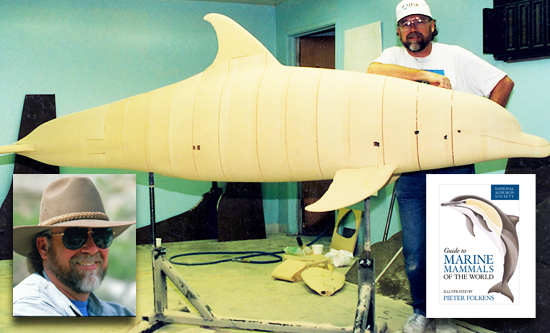
24 May “First Expressed in Nature”: Science Illustrator Pieter Folkens Raises Copyright Concerns
Science illustrator Pieter Folkens came to our attention when we put out a call for a visual artist with experience in the entertainment industry. Not only is he a renowned marine mammal artist, Folkens has also created animatronics models used in films such as “Free Willy” and “Star Trek VI: The Voyage Home”. In April, Folkens represented visual artists with the Copyright Alliance at “Beyond the Red Carpet,” an event which showcased the creatives working behind the scenes in the film industry. The Alliance interviewed Folkens for their “Five Questions” interview series with individual creators.
“Five Questions with Science Illustrator Pieter Folkens” covers his early fascination with marine mammals, triggered by the discovery of fossilized shark teeth during a third-grade field trip, and shortly thereafter, excavating a 13.5 million year old sperm whale skull. That experience eventually led to a satisfying career documenting whales, dolphins, porpoises, and other marine life in scientific illustration and sculpture. As Folkens put it, “The creative process is an exercise in discovery. The enjoyment comes in two forms—initially learning new things followed by sharing them with others.”
However, it’s the Alliance’s probing of Folkens’ experience with copyright infringment which is particularly illuminating. Folkens was one of the first science illustrators to focus on marine mammals, and his high-quality illustration has often been copied – his work has been infringed up to a dozen times a year (that he knows of). His method of dealing with the infringement is to send a passive notification, followed by an invoice for the use, and an attorney’s letter. This sequence of steps permits Folkens to gauge the infringer’s response and anticipate what steps he’ll need to take. He strongly advises creators to “learn copyright law,’ recommending that they stay abreast of recent case law.
It’s clear he’s followed his own advice in his response to the final question, on what he would change about copyright law. Folkens cites concerns with the merger doctrine and scenes à faire doctrine, two principles most visual artists are unaware of. (Put very simplistically, the merger doctrine states that when an idea and the expression of that idea are so closely tied together that they’re inseparable, then the expression can’t be copyrighted since ideas are not copyrightable. The scenes à faire doctrine states that elements of a creative work may not be copyrightable if the genre of the work dictates them – think of folklore, stock story lines, etc.) Folkens’ concern is that these doctrines are unfairly applied to works of visual arts, citing a comprehensive law review article by attorney Michael D. Murray.
In response to our query, Folkens went into greater detail:
“The issue is developing wrongly in the courts under the notion of “first expressed in nature” that says any depiction of an animal is not protectable because whatever an animal looks like or does was “first expressed in nature” and therefore not a copyrightable idea. (Taken to its extreme, Ansel Adams’ “Moon Over Half Dome” would not be a copyrightable subject because Half Dome is a rock that was first expressed in nature, and same goes for the moon.) It sounds absurd, but it has been a successful defense in several cases in the Ninth Circuit, even when the copying of the original was proven by the plaintiffs. The problem arises from the two step “reductive analysis” employed by the court that essentially removes all elements of expression in the first step (copyrightablity of the subject), keeping the second step (copying of protected elements) out of consideration and away from the trier of fact. I’m taking up that battle in the Ninth Circuit this fall.”
Folkens’ full interview can be read on the Copyright Alliance’s website. Folkens’ will also be presenting our June webinar with attorney Linda Joy Kattwinkel on “Inspiration or Infringement.”
